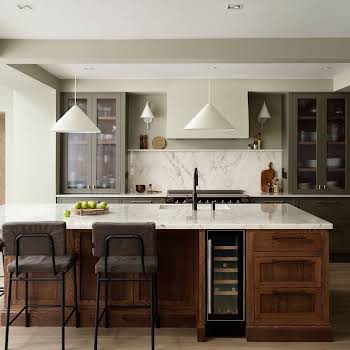Prefabricated homes are not the draughty builder's office you're imagining, as these design-focused modular homes prove.
We tend to be suspicious of prefabricated and modular buildings. “They’re not well-made” or “they won’t last,” are two typical insults levelled at a prefab building.
And understandably so. Anyone who spent their Leaving Cert maths class in a school prefab knows they can be cold, dark and so draughty that even on the hottest day in June, they still seem to manifest their own stiff breeze.
However, prefabricated buildings have come a long way since our school days. Not only are they now well-insulated and snug, but construction time is quicker and cheaper than a typical build.
They usually arrive completely finished including water and electricity – some are even painted. They’re also better for the environment as they don’t typically require foundations or an excessive amount of heavy machinery on-site and there’s less waste as each piece is precision cut and built in the factory before being shipped out.
And now, they’ve got sleek design going for them too. More and more architects are turning to the idea of prefabricated buildings, which allows them and the homeowner far greater control over the design and layout.
It is worth flagging, though, that if you do intend on living in it full-time in Ireland, you will probably require planning permission from your local county council, so it’s worth making this your first priority before diving into the design bit.
However, even after you factor in the planning process, a prefabricated building can often work out cheaper, faster and more environmentally friendly than a traditional new build.
From timber-clad cabins to glass-fronted mansions, there’s a prefab home out there for just about anyone who fancies it.
ÁPH80 Transportable House by Abaton

Made using cement wood board panelling, this tiny home has been carefully proportioned to ensure it feels much bigger than its 27 square metres.

Designed by Madrid architecture firm Ábaton, the portable cabin has won numerous prizes and is designed to be closed up for the season or quickly loaded onto a truck for its next adventure.
The Mountain Refuge

A fairly new tiny homes start-up, Italian architects Massimo Gnocchi and Paolo Danesi came up with the idea after looking at new ways to design a hikers’ shelter. A two-module building, as pictured above, is about 24 square metres, with prices starting at €79,000.

The exterior timber ply is coated in tar to make it waterproof. Inside, the small space can be reconfigured to suit you but can hold a bed, living area, kitchen and dining area. While the designers are currently looking for large-scale manufacturers around the world to partner with, they are taking individual orders and working on other designs.
Yo no Ie House by Muji

Made with Japanese cedar and a Galvalume steel roof, this Muji house is designed with accessibility and connection to the outside in mind. It’s fitted out with Muji’s signature minimalist style and the deck features a sunken area, ideal for a fire pit or vegetable garden.

The Yo no Ie House costs in the region of €140,000, but unfortunately it’s only available in Japan right now, although pre-Covid the brand was working on shipping it internationally.
Huf Haus

If you’re looking for something a little less cabin-like and a little more, well, palatial, German brand Huf Haus has been making prefab homes since 1912, so you know they have the process down pat.
All units come triple-glazed and heavily insulated with an air-source heat pump and underfloor heating.

They also have a showroom in the UK so you can see some of their glass-focused timber-framed designs first-hand.
Vipp Shelter

The Scandinavian brand is known for its iconic steel wastepaper bin and free-standing kitchen units, but Vipp has also created a holiday rental with a difference. Dropped into the Danish woodland is the Vipp Shelter, a one-bed home that stretches to 55 square metres.

While the design isn’t available to purchase at the minute, the pre-fabricated steel home is too stunning not to show you and it will give you an idea of what is achievable.

If you want to test out prefab living you can rent it, it’s available for €1,000 for two nights for two adults.
Ark Shelter
Made with sustainable living in mind, this shelter is designed to have as little impact on its surrounding environment as possible. They can work as offices, extensions and garden rooms as well as homes, and can be extended with more modules as you need it.

The 27-square-metre Ark Shelter comes fully furnished to your specifications while the large windows maximise light. They can also go entirely off the grid with a few tweaks and don’t require any fixed foundations.
Koda

Available in concrete or timber-framed designs, Koda houses are designed to fit in amongst the small gaps created by rapid urban development. Koda has an Irish base in Arklow too, so you can see the modules and variety of interiors for yourselves.

Maximising on space and storage, these houses start at 20 square metres in a timber-clad Koda Compact for €59,600, right up to a 26.4-square-metre Koda Concrete for €114,400.

The Koda house comes with items like a bed, kitchen, fridge and lighting all included and prices include delivery within Europe. They’ve even got a floating Koda, ideal for a canal or clam waterway.
MiniMod by Mapa Architects

Created by Brazilian architecture firm Mapa, Minimod comes in four designs, varying from the Spot, a dinky 4-square-metre pod ideal for a covered viewing spot, up to Retreat, a 110-square-metre home (above). Within each design, there is room to play too, designed to fit the site and the purpose you require.

Minimod Shelter
For example, the Shelter is a cube shape that can be arranged to work as a building from 20 square metres to 55 square metres. Each building is made from solid engineered and digitally milled wood panels, making construction precise and fast, and also environmentally friendly.

Interiors of a Minimod Retreat
What’s available in Ireland?
While many prefab companies do deliver to Ireland, there are also some homegrown options. Belfast-based architecture firm Koto design sleek log cabins and playhouses, you can read more about them here.
Monaghan’s Built Wright is redefining modular homes in Ireland, building large-scale projects with big design ideas. Their concrete homes arrive onsite in turnkey condition and the construction takes less than a day.
On a slightly smaller scale, TinyHomes.ie create prefabricated structures that are ideal for granny flats or house extensions that can be built and delivered in about six weeks, with prices starting from €29,500.
Featured image:ÁPH80
This article was originally published in February 2022.























